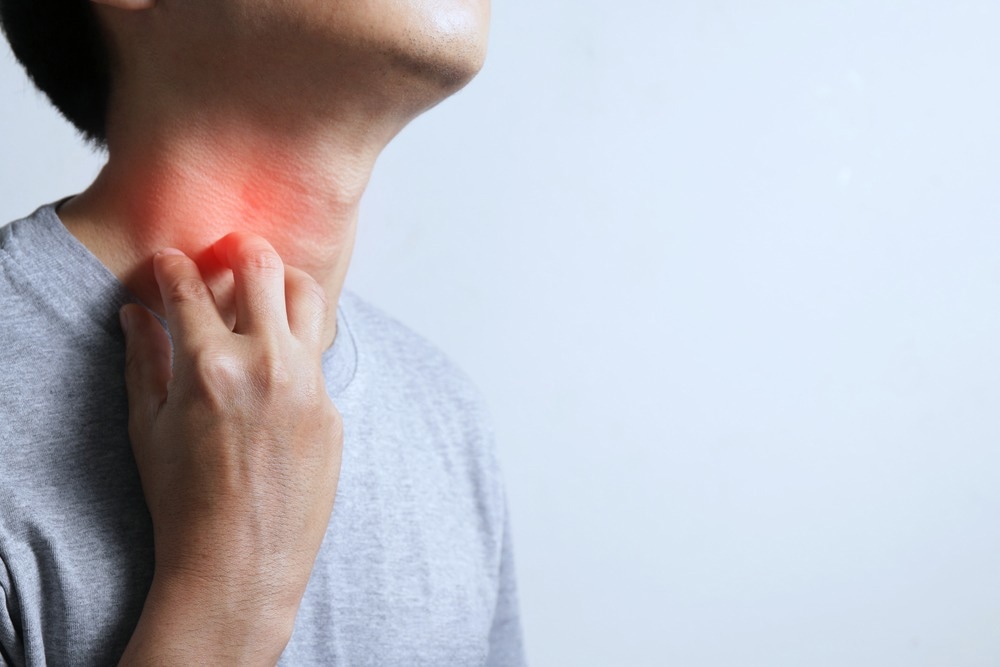Introduction
Understanding the itch sensation
The neurological underpinnings of itch
Chronic itch and its impact
Advances in itch research and treatment
Practical management and prevention of itch
Conclusion
References
Further reading
Itch is a complex process in skin neurobiology. Understanding pruritus, commonly known as itch, and its chronic forms is a key step in developing effective treatment and management strategies to improve the quality of life in affected patients.

Image Credit: Andrey_Popov/Shutterstock.com
Introduction
Itch, also known as pruritus, is an unpleasant sensation that triggers the urge to scratch. It is a common problem experienced by many individuals, with causes ranging from dermatologic conditions to systemic, paraneoplastic, neuropathic, and psychogenic factors. 1
Itching involves the transmission of pruritic nerve impulses from the thalamus to various brain regions, including subcortical and cortical areas related to sensory perception, evaluation, motivation, attention, emotion, and motor planning.2 Scratching also activates the reward system, providing a feeling of pleasure.
Chronic itch is influenced by both peripheral and central sensitization mechanisms, involving heightened pruritogenic receptor activity on nerve fibers and neural plasticity, respectively.2
Due to the diverse etiology of itch, it is a difficult condition to treat in medical practice. This article will focus on the recent advances in pruritus research and its implications for treatment.
Understanding the itch sensation
Itch and pain are distinct yet interconnected sensations. They share common mediators and receptors, and itch-responsive neurons can also detect pain stimuli.3 Some common receptors in itch-primary sensory neurons include Mrgprs, PARs, NKR1, JAK, histamine receptors, TGR5, TLRs, and TRPV1/A1 subfamily.3-4
Recent findings highlight the presence of a specific neural circuitry for itch, where MrgprA3-expressing neurons in the skin connect with GRPR-expressing neurons in the spinal cord.3 Disrupting these neuronal pathways selectively reduces itch but not pain. While acute pain and itch differ significantly, chronic pain and itch share similar mechanisms, including peripheral and central sensitization, loss of spinal cord inhibitory control, and interaction between neurons, immune cells, and glial cells.3
It is important to consider that pruritus can be a manifestation of various conditions, such as dermatological and systemic diseases. Some dermatological diseases causing itch are atopic dermatitis, seborrheic dermatitis, psoriasis, dermatophytosis, cutaneous T-cell lymphoma, and more.2
Some systemic diseases provoking pruritus are cholestasis, kidney disease, multiple sclerosis, hematopoietic diseases, connective tissue disorders, depression and stress, specific types of medications (e.g., opioids), and HIV, to name a few.2
The neurological underpinnings of itch
Upon tissue damage or inflammation, skin, and immune cells release itch mediators that activate pruriceptors in nerve terminals.3 These pruritogens, including ET-1, serotonin, histamine, tryptase, thromboxanes, leukotrienes, bile acids, LPA, NGF, TNF-α, and RNAs, directly bind to their receptors on pruriceptors.3 This receptor activation triggers PLCβ3 and increases intracellular calcium through TRPV1 and/or TRPA1, leading to itch transduction and sensation. It also releases additional mediators, inducing neurogenic inflammation that enhances itch signaling.3
These signals are sent to the spinal cord. From there, the signals travel along the spinothalamic tract (STT), which transmits information about sensations, such as pain, temperature, touch, and itch, to the thalamus.1 The thalamus then relays this information to the brain's center for perceptual awareness, the sensory cortex, generating a response (act of scratching) that has a calming effect over STT neurons, providing relief from the itch sensation. 1

Image Credit: Nakharin T/Shutterstock.com
In recent years, scientists have found non-canonical pruritogens and receptors involved in itch signaling, such as the cytokine oncostatin M (OSM) acting through its receptor OSMR5, as well as LTC4 acting through CysLT2R6.
Chronic itch and its impact
Itch not only affects patients' physical health, but it is a complex sensory component that includes discriminative, cognitive, motivational, and affective aspects.7 Recent studies have highlighted the importance of the affective dimension of itch.7 Chronic itch conditions are associated with higher rates of stress, anxiety, depression, and even suicidal ideation, leading to major deficits in quality of life.7
In particular, the interaction of pruritus, stress (the activation of the HPA axis), and anxiety (the subjective experience of fear or threat avoidance) has important implications for patients.7 Chronic itch is associated with increased anxiety and, in turn, anxiety and stress tend to exacerbate itch, leading to a vicious cycle not unlike the itch-scratch cycle.7
Different anti-anxiety drugs have shown promising results in breaking this cycle, producing a reduction of itch sensation and even clearance of skin affections in some cases.7 Some of these drugs are SSRIs (e.g., Paroxetine and fluvoxamine), Tricyclic and Tetracyclic Antidepressants (e.g., Doxepin), Benzodiazepenes (e.g., Midazolam), and GABA Analogs (e.g., Gabapentin or pregabalin).7
Advances in itch research and treatment
Currently, there is a lack of FDA-approved medications specifically designed for chronic itch.8 The complex underlying causes and pathogenesis of chronic itch make it one of the major healthcare challenges.8
While humanized antibodies targeting IL-13, IL-4, and IL-31 have shown effectiveness in treating itch associated with atopic dermatitis, their validation in chronic itch is still pending.8 Furthermore, there is a lack of satisfactory anti-itch therapies targeting neuropeptides such as GRP, BNP, SST, CGRP, and SP.8
However, the identification of potential itch targets like OSM, NMB, glutamate, periostin, and Serpin E1 has opened up new possibilities for therapeutic development.8 Different studies have demonstrated the successful use of antagonists against these proteins and their receptors in animal models of itch.8
Although substantial research has been conducted to fill the gaps pertaining to the mystery of itching, this debilitating clinical condition is still faced with a highly inadequate medical need for efficient treatment.8 No neuropeptide-targeting therapeutic or agonist/antagonist has achieved complete successful chronic itch resolution in humans.8
Nonetheless, treatments with dupilumab, the Janus kinase inhibitor ruxolitnib, the phosphodiesterase 4 inhibitor crisaborole, and thalidomide have shown good anti-inflammatory properties in the treatment of chronic itch.8
Practical management and prevention of itch
Managing and preventing every day itches can be a challenge, but there are tips and strategies to help. Skincare plays a vital role, with moisturizing regularly and using gentle cleansers to maintain healthy skin.
Making lifestyle changes, such as avoiding triggers like harsh fabrics or excessive heat, can also reduce itchiness. Over-the-counter remedies like antihistamines or topical creams can provide relief.8
Seeking medical advice is crucial, as it can offer tailored guidance and treatment options, suggesting techniques for stress management or prescription medications for chronic itch.7
By combining these approaches, individuals can effectively manage and prevent every day itches for improved quality of life.
Conclusion
Understanding the neurobiology of itch is crucial for developing effective treatment and management strategies. Unraveling the complex neural pathways involved in itch creates the potential for targeted interventions and improved therapies in the future.
References
- Roh YS, et al.(2022). Itch: Epidemiology, clinical presentation, and diagnostic workup. Journal of the American Academy of Dermatology, 86(1), 1–14. https://doi.org/10.1016/j.jaad.2021.07.076
- Lavery MJ, et al.(2016) Pruritus: an overview. What drives people to scratch an itch? Ulster Med J. Sep;85(3):164-173. PMID: 27698518; PMCID: PMC5031103.
- Liu T, et al.2013). New insights into the mechanisms of itch: Are pain and itch controlled by distinct mechanisms? Pflügers Archiv - European Journal of Physiology, 465(12), 1671–1685. https://doi.org/10.1007/s00424-013-1284-2
- Martins MS, et al. (2023). Chronic pruritus: From pathophysiology to drug design. Biochemical Pharmacology, 212, 115568. https://doi.org/10.1016/j.bcp.2023.115568
- Tseng PY, et al.(2021). Oncostatin M can sensitize sensory neurons in inflammatory pruritus. Science Translational Medicine, 13(619). https://doi.org/10.1126/scitranslmed.abe3037
- Voisin T, et al.(2021). The CysLT2R receptor mediates leukotriene C4-driven acute and chronic itch . Proceedings of the National Academy of Sciences, 118(13). https://doi.org/10.1073/pnas.2022087118
- Sanders KM, et al.(2018). The vicious cycle of itch and anxiety. Neuroscience & Biobehavioral Reviews, 87, 17–26. https://doi.org/10.1016/j.neubiorev.2018.01.009
- Yang H, et al.(2022). Critical players and therapeutic targets in chronic itch. International Journal of Molecular Sciences, 23(17), 9935. https://doi.org/10.3390/ijms23179935
Further Reading
Last Updated: Jan 11, 2024